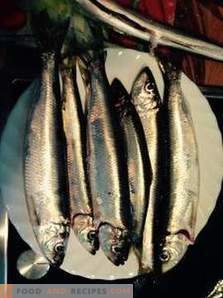
Herring is a remarkably healthy and at the same time incredibly tasty product. She appeared in the diet of Europeans in the 15th century. Since then, various nations have invented many of their own recipes for the preparation of this fish. For example, in Norway, herring in general is one of the most basic foods. In Russian cuisine, she also always occupied a significant place. It has long been used both fresh and salted.
Herring popularity is not accidental. In addition to the availability and nutritional value, the fish is characterized by a large number of useful qualities. Due to the high (up to 25%) fat content and the omega-3 unsaturated acids contained in it, it helps to increase the efficiency of thinking abilities and processes of remembering information, has a beneficial effect on fetal development, is indicated for problems with the heart and blood vessels, and provides a good anti-inflammatory effect .
In addition, herring is a source of vitamins B, as well as A, D, E and PP.
But in order for the fish to become a useful additive to your table, you must be able to choose and store it.
How to make the right choice
If you get a fresh fish for subsequent cooking at home, you need to carefully examine its appearance.
- A good herring always has a brilliant, intact, silver-colored skin. The appearance of a rusty-yellowish shade on it is unacceptable.
- The carcass of fresh herring is always elastic and, when pressed, quickly acquires its former shape.
- Look at the fish in the eye. They should be clean and slightly bulged.
- Herring gills, like other fish, should be red.
- The fins and gill covers of the “correct” fish are tightly pressed to the body.
- Try to buy herring caught in the winter. Such specimens will be the fattest and tasty.
- The best taste will be in dishes prepared from specimens with a wide back and rounded sides.
- When purchasing fresh-frozen fish, do not select deformed or damaged carcasses.
- Beware of buying a headless product, since with such a purchase you will not be able to evaluate its freshness by the main indicators - the eyes and gills.
- It is better to stop the choice on medium-sized specimens, because large fishes accumulate much more harmful substances like heavy metals.
When choosing salted herring, regardless of the method of its preparation, you should always follow the following rules.
- First, pay attention to the color of the scales. Its “rusty” hue indicates the beginning of the oxidative process, in which not only the peel suffers, but also the flesh of the fish.
- The gills of a freshly-salted herring have a smooth dark red color. When pressed on them should not appear blood flow. Their presence indicates a violation of the technology of preparation of the product.
- Good specimens must be resilient, stains or damage is unacceptable.
- The fish should not have an unpleasant smell and a very swollen belly. These signs indicate that the product is flawed.
- Less salted herring is usually red in the eyes.
- Just like fresh, the most delicious will be a salty fish with a thick back and a rounded tummy.
How to save herring correctly
If you bought a fish, taking into account all the above rules, its storage will not cause you unnecessary problems. Terms and conditions depend only on what kind of product you purchased: fresh or salty.
When storing fresh fish, follow these rules:
- If immediately after purchase you do not plan to cook the herring, it must be washed, dried and placed in the refrigerator, but better - in the freezer.
- Fish with entrails must be gutted, as they create excellent conditions for the reproduction of various pathogens.
- Before placing the herring in the refrigerator or freezer, be sure to pack it in polyethylene or foil so that it does not lose its freshness.
- In the refrigerator, fresh herring needs to be kept at a temperature of about 0 ° C for no more than 2 days. When stored in a common refrigerating chamber, which usually has a temperature of about + 5 ° C, this period is reduced to one day.
- Do not place fish in the vicinity of dairy products, as they quickly become saturated with the smell of herring and will get a very unpleasant taste.
- If possible, keep the peel when processing fish. It will not allow the product to lose taste and useful properties. This will certainly happen when the peeled fillet is put in storage.
- When freezing, herring, previously cleaned and dried, is first placed separately on a plate or tray and placed in the freezer compartment, by turning on the “Super Frost” function. Subsequently, the fish is packaged and placed in the freezer for long-term storage, the period of which should not exceed six months.
- It is not recommended to keep whole specimens and fillets together. It is better to pack them in different water and airtight containers.
- Another way of long-term storage of herring is its independent ambassador. There are many simple and original recipes, choosing one of which you will provide for your family and delight guests with a delicious snack.
Storage of salted herring also requires compliance with several mandatory rules:
- Depending on the nature of the container, herring should be stored in an intact original packaging at a temperature of about + 5 ° C. Under these conditions, the longest time is stored product in a tin container - up to 4 months. Plastic packaging will ensure safety for 3 months, and vacuum - up to 35 days.
- Herring freed from factory packaging is not recommended to be stored in a domestic refrigerator for more than 3-4 weeks. These terms are only suitable for storage in brine and in the appropriate container.
- For long-term storage in the refrigerator, the product is placed in glass or ceramic dishes and must be tightly closed with a lid. You can cover the container with parchment paper, tightly pressing it around the neck with string.
- If you did not have enough brine from the package to completely cover the fish, you can top up the container with your own homemade solution. To do this, add 200 grams of salt to 1 liter of water, boil and cool everything to room temperature.
- Herring will be well preserved in a pouring of beer boiled together with bay leaf and peppercorns. This cooled solution is poured over it, placed in a glass container, and a tablespoon of vegetable oil is poured on top and tightly covered with a lid or parchment.
- Without brine fish in the refrigerator should not be stored for more than 2 days.
- It is possible to increase its refrigerated storage time up to 4 days, if you cut the purified product into small slices and cover it with vegetable oil, after placing it in a glass container.
- Purified salted herring can be frozen and stored in such conditions for up to 6 months.























